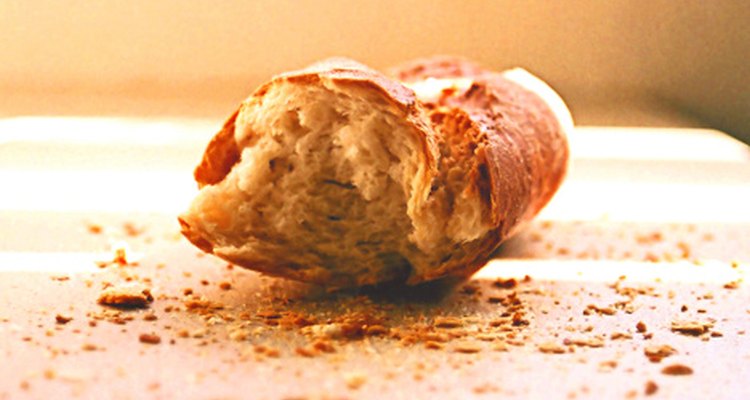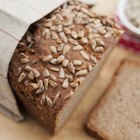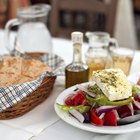
Italy and France specialize in the making of bread, but you will find it hard to strike any similarities between the two. Anything from the bread's baking method down to its shape and size is usually done in a different way on either side of the French-Italian border. Some of the most common variations to look out for include the differences in bread dough and the ingredients used.
Shape and Size
The bread's shape and size is usually what strikes you first when eating in any country. Some loaves might be small and round while others might be flat or wide. In this particular case, Italian and French breads differ quite significantly. The French baguette, for example, symbolizes the country's food and is always baked in a long and thin shape. Some baguettes can be baked as long as 30 inches. Italian focaccia, on the other hand -- also a symbol of the country's culinary prowess -- is flat and round, looking much like a pizza base. An Italian piadina -- a Romagna flatbread -- also differs in size and shape from a French bun.
Sweet and Savory
France is also famed for its brioche, a sweet bread often served for breakfast. The sweetness of the bread comes from its enrichment, which describes the extra amounts of unsalted butter and eggs that go into the dough.
Italy is famed instead for its savory breads. One in particular is Carasau bread from Sardinia, which is baked into very flat sheets and usually eaten with savory ingredients such as pork and cheese or tomato and eggs.
Baking Ovens

Italian breads are often baked in a flat stone oven like their pizzas. Pane di Genzano is a fragrant and long-lasting bread from Lazio that is commonly cooked in a wood-fire or stone oven. This particular style of baking gives the product its smoky flavor and signature aroma.
The French, on the other hand, are famed for using electric convection deck ovens for baking their bread. This method of baking gives the loaf a softer and less chewy texture and allows bakers to give loaves a more even crumb.
Complimenting Food
Another difference between the breads of both countries is how they are served and what they are served with. Because bread accompanies main meals in both countries you might think that they are served for the same reason, but this is not true. France, for example, commonly serves bread as a starter with butter and perhaps soup if the diner is eating an entrée. Italian restaurants, on the other hand, are more inclined to serve bread as an accompaniment to the pasta and main courses.
Related Articles

What Is Indian Flat Bread Called?

What Is Artisan Bread?

What Kind of Bread Do I Serve With ...

Russian Rye Bread vs. Pumpernickel

What Is Unleavened Bread?

What Is the Difference Between a Bagel ...

How to Make Egyptian Bread the Egyptian ...

Types of Cheese Used in Pizza

Different Breads From Different ...

Lumpia vs. Egg Rolls

List of Greek Breads

What Is the Difference Between Scones & ...

How to Make Communion Bread Wafers

How to Freeze Brioche

What Are Rusk Crumbs?

How to Make Bread Tender
What Is Rusk Bread?

What Is Docking Used for in Baking?
Can You Refrigerate Homemade Yeast ...

How Long Would it Take to Bake a 1.6 Lb ...
References
Writer Bio
Matthew Caines began writing and editing in 2008 and has since gained valuable experience in the publishing industry working for national publications such as "The Guardian," "Sartorial Male," "AREA Magazine," "Food & Drink Magazine," "Redbrick Newspaper" and "REACH Magazine." He has a Bachelor of Arts in history from the University of Birmingham, U.K.
Photo Credits
baguette image by kruszek from Fotolia.com